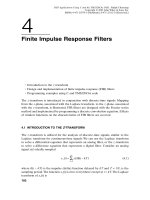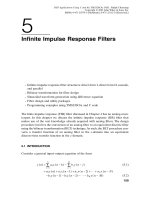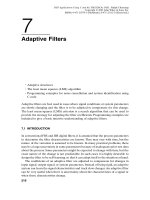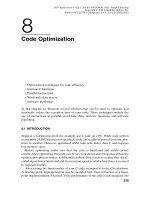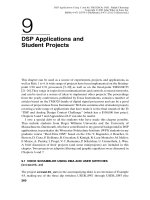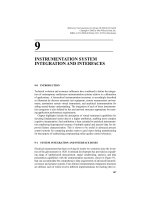Tài liệu DSP applications using C and the TMS320C6X DSK (P9) doc
Bạn đang xem bản rút gọn của tài liệu. Xem và tải ngay bản đầy đủ của tài liệu tại đây (138.63 KB, 16 trang )
9
DSP Applications and
Student Projects
260
This chapter can be used as a source of experiments, projects, and applications, as
well as Refs. 1 to 4.A wide range of projects have been implemented on the floating-
point C30 and C31 processors [5–20] as well as on the fixed-point TMS320C25
[21–26].They range in topics from communications and controls, to neural networks,
and can be used as a source of ideas to implement other projects. The proceedings
from the yearly conferences, published by Texas Instruments, contain a number of
articles based on the TMS320 family of digital signal processors and can be a good
source of project ideas.Texas Instruments’ Web site contains a list of student projects
covering a wide range of applications that have made it to the final rounds of the TI
“DSP and Analog Design Contest Challenge” (which has a $100,000 first prize).
Chapters 6 and 7 and Appendices D–F can also be useful.
I owe a special debt to all the students who have made this chapter possible.
They include students from Roger Williams University and the University of
Massachusetts–Dartmouth, who have contributed to my general background in DSP
applications, in particular the Worcester Polytechnic Institute (WPI) students in my
graduate course “Real-Time DSP,” based on the C6x: Y. Bognadov, J. Boucher, G.
Bowers, D. Ciota, P. DeBonte, B. Greenlaw, S. Kintigh, R. Lara-Montalvo, M. Mellor,
F. Moyse, A. Pandey, I. Progri, V. C. Ramanna, P. Srikrishna, U. Ummethala, L. Wan.
A brief discussion of their projects (and some miniprojects) are included in this
chapter. Two projects on adaptive filtering and graphic equalizers were discussed in
Chapters 6 and 7.
9.1 VOICE SCRAMBLER USING DMA AND USER SWITCHES
(scram16k_sw)
The project scram16k_sw (on the accompanying disk) is an extension of Example
4.9, making use of the three dip switches, USER_SW1 through USER_SW3 (the
DSP Applications Using C and the TMS320C6x DSK. Rulph Chassaing
Copyright © 2002 John Wiley & Sons, Inc.
ISBNs: 0-471-20754-3 (Hardback); 0-471-22112-0 (Electronic)
fourth switch is not used), available on board the DSK. With voice as input, the
output can be unscrambled voice (based on the user switch settings).
The user dip switches are used to determine whether or not to up-sample. The
program can also be used as a loop or filter program, depending on the position
of the switches. USER_SW1 corresponds to the LSB. A setting such as “down/
down/up” represents (001)
b
and is the first one tested in the program. If true, the
output is scrambled with up-sampling at 16kHz. The following switch positions are
used:
USER_SW1 USER_SW2 USER_SW3
a. 0 0 1 Output scrambled with F
s
= 16 kHz
b. 1 0 1 Output unscrambled with F
s
= 16 kHz
c. 1 1 1 Lowpass filtering with F
s
= 16 kHz
d. 0 1 0 Output scrambled with F
s
= 8 kHz
e. 1 1 0 Output unscrambled with F
s
= 8 kHz
f. 0 0 0 Lowpass filtering with F
s
= 8 kHz
g. 1 0 0 Loop program
scram8k_DMA
The alternative project scram8k_DMA (on the disk) implements the voice scram-
bling scheme using DMA, sampling at 8kHz. It is adapted from the example
codec_edma included with the DSK package. It illustrates the use of DMA with
options within the program to inplement either a loop program, a filter, or the voice
scrambling scheme (without up-sampling).
9.2 PHASE-LOCKED LOOP
The PLL project implements a software-based linear phase-locked loop (PLL). The
basic PLL causes a particular system to track another PLL. It consists of a phase
detector, a loop filter, and a voltage-controlled oscillator. The software PLL is more
versatile. However, it is limited by the range in frequencies that can be covered,
since the PLL function must be executed at least once every period of the input
signal [27–29].
Initially, the PLL was tested using MATLAB, then ported to the C6x using C.
The PLL locks to a sine wave, generated either internally within the program or
from an external source. Output signals are viewed on a scope or on a PC using
DSP/BIOS’s real-time data transfer (RTDX).
Figure 9.1 shows a block diagram of the linear PLL, implemented in two
versions:
1. Using an external input source, with the output of the digitally controlled
oscillator (DCO) to an oscilloscope
Phase-Locked Loop
261
262
DSP Applications and Student Projects
2. Using RTDX with an input sine wave generated from a lookup table and
various signals viewed using Excel
The phase detector, from Figure 9.1, multiplies the input sine wave by the square-
wave output of the DCO. The sum and difference frequencies of the two inputs to
the phase detector produces an output with a high- and a low-frequency compo-
nent, respectively. The low-frequency component is used to control the loop, while
the high-frequency component is filtered out. When the PLL is locked, the two
inputs to the phase detector are at the same frequency but with a quadrature
(90-degree) relationship.
The loop filter is a lowpass filter that passes the low-frequency output compo-
nent of the phase detector while it attenuates the undesired high-frequency com-
ponent. The loop filter is implemented as a single-pole IIR filter with a zero to
improve the loop’s dynamics and stability. The scaled output of the loop filter
represents the instantaneous incremental phase step the DCO is to take. The DCO
outputs a square wave as a Walsh function: +1 for phase between 0 and pi, and -1
for phase between -pi and 0; with incremental phase proportional to the number
at its input.
External
signal
source
A/D
Converter
Software
signal
source
u
2
, w
2
, φ
2
Phase
detector (K
d
)
Loop filter
(F(s), K
a
)
u
d
u
1
, w
1
, φ
1
u
f
Digitally
controlled
oscillator (K
0
)
RTDX
target
interface
PC
Excel
VB macro
OLE
CCS
R
T
D
X
D/A
converter
Scope
JTAG
FIGURE 9.1. PLL block diagram.
SB-ADPCM Encoder/Decoder: Implementation of G.722 Audio Coding
263
9.2.1 RTDX for Real-Time Data Transfer
The RTDX feature was used to transfer data to the PC host using a sine wave from
a lookup table as input. A single output channel was created to pass to CCS the
input signal, the output of both the loop filter and the DCO, and time stamps. CCS
buffers these data so that the data can be accessed by other applications on the PC
host. CCS has an interface that allows PC applications to access buffered RTDX
data. Visual Basic Excel was used (LABVIEW, or Visual C++ can also be used) to
display the results on the PC monitor.
9.3 SB-ADPCM ENCODER/DECODER: IMPLEMENTATION OF
G.722 AUDIO CODING
An audio signal is sampled at 16kHz, transmitted at a rate of 64 kbits/s, and recon-
structed at the receiving end [30,31].
Encoder
The subband adaptive differential pulse code modulated (SB-ADPCM) encoder
consists of a transmit quadrature mirror filter that splits the input signal into a low-
frequency band, 0 to 4kHz, and a high-frequency band, 4 to 8kHz. The low- and
high-frequency signals are encoded separately by dynamically quantizing an adap-
tive predictor’s output error.The low and the high encoder error signals are encoded
with 6 and 2 bits, respectively.As long as the error signal is small, a negligible amount
of overall quantization noise and good performance can be obtained. The low- and
high-band bits are multiplexed and the result is 8 bits sampled at 8kHz, for a bit
rate of 64kbits/s. Figure 9.2 shows a block diagram of a SB-ADPCM encoder.
Transmit Quadrature Mirror Filter
The transmit quadrature mirror filter (QMF) takes a 16-bit audio signal sampled
at 16kHz and separates it into a low band and a high band. The filter coefficients
represent a 4-kHz lowpass filter. The sampled signal is separated into odd and even
samples, with the effect of aliasing the signals from 4 to 8kHz. This aliasing causes
the high-frequency odd samples to be 180 degrees out of phase with the high-
frequency even samples. The low-frequency even and odd samples are in-phase.
When the odd and even samples are added, after being filtered, the low-frequency
FIGURE 9.2. Block diagram of ADPCM encoder.
Higher subband
ADPCM encoder
Lower subband
ADPCM encoder
Transmit
quadrature
mirror filters
X
in
– 16 bits
at 16 kHz or
256 kbits/s
X
out
– 8 bits
at 8 kHz or
64 kbits/s
16 bits
at 8 kHz or
128 kbits/s
16 bits
at 8 kHz or
128 kbits/s
2 bits
at 8 kHz or
16 kbits/s
6 bits
at 8 kHz or
48 kbits/s
M
U
X
264
DSP Applications and Student Projects
signals constructively add, while the high-frequency signals cancel each other, pro-
ducing a low-band signal sampled at 8kHz.
The low subband encoder converts the low frequencies from the QMF into an
error signal that is quantized to 6 bits.
Decoder
The decoder decomposes a 64-kbits/s signal into two signals, to form the inputs
to the lower and higher SB-ADPCM decoder, as shown in Figure 9.3. The receive
quadrature mirror filter (QMF) consists of two digital filters to interpolate the
lower- and higher-subband ADPCM decoders from 8 to 16 kHz and produce out-
put at a rate of 16kHz. In the higher SB-ADPCM decoder, adding the quantized
difference signal to the signal estimate produces the reconstructed signal.
Components of the ADPCM decoder include an inverse adaptive quantizer,
quantizer adaptation, adaptive prediction, predicted value computation, and recon-
structed signal computation. With input from a CD player, the DSK reconstructed
output signal sound quality was good. Buffered input and reconstructed output data
also confirmed successful results from the decoder.
9.4 ADAPTIVE TEMPORAL ATTENUATOR
An adaptive temporal attenuator (ATA) suppresses undesired narrowband signals
to achieve a maximum signal-to-interference ratio. Figure 9.4 shows a block diagram
of the ATA. The input is passed through delay elements, and the outputs from
selected delay elements are scaled by weights. The output is
where m is a weight vector, r a vector of delayed samples selected from the input
signal, and N the number of samples in m and r. The adaptive algorithm computes
the weights based on the correlation matrix and a direction vector:
where C is a correlation matrix, D a direction vector, and l a scale factor. The
correlation matrix C is computed as an average of the signal correlation over several
samples:
CmDkk,dl=
[]
◊
[]
=0
yk k k i
T
i
i
N
[]
=◊
[]
=◊-
[]
()
=
-
Â
mr mr
0
1
FIGURE 9.3. Block diagram of ADPCM decoder.
64 kbits/s
16 Kbits/s
48 Kbits/s
DMUX
Higher subband
ADPCM decoder
Lower subband
ADPCM decoder
Receive
quadrature
mirror filters
Image Processing
265
where N
AV
is the number of samples included in the average. The direction vector
D indicates the signal desired:
where w
T
is the angular frequency of the signal desired, t the delay between samples
that create the output, and N the order of the correlation matrix.
This procedure minimizes the undesired-to-desired ratio (UDR) [32]. UDR is
defined as the ratio of the total signal power to the power of the signal desired, or
where P
d
is the power of the signal desired.
MATLAB is used to simulate the ATA, then ported to the C6x for real-time
implementation. Figure 9.5 shows the test setup using a fixed desired signal of
1416Hz and an undesired signal of 1784 Hz (which can be varied). From MATLAB,
an optimal value of t is found to minimize UDR. This is confirmed in real time, since
for that value of t (varying t with a GEL file), the undesired signal (initially dis-
played from an HP3561A analyzer) is greatly attenuated.
9.5 IMAGE PROCESSING
This project implements various schemes used in image processing:
UDR
total
==
[]
◊
[]
◊
[]
[]
◊
()
=
[]
◊
()
P
P
kk k
Pk
Pk
d
T
d
T
d
T
mC m
mD
mD
,0 1
2
D =
()
◊◊◊ -
()()
[]
11exp expjjN
TT
T
wt w t
Crrk
N
kk
T
i
n
,dd
[]
=
[]
ƒ-
[]
()
=
-
Â
1
0
1
AV
FIGURE 9.4. Block diagram of adaptive temporal attenuator.

